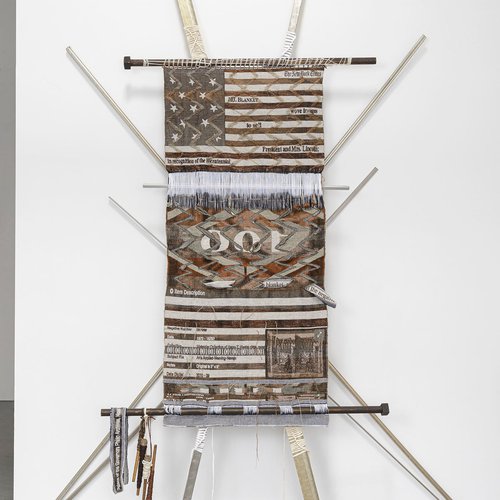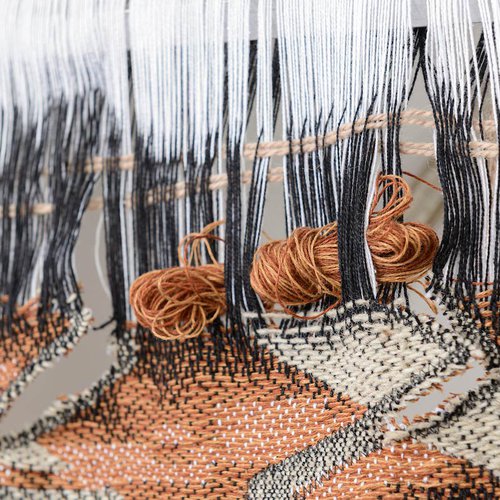Alum spotlight: Kira Dominguez Hultgren’s woven histories
Textile artist Kira Dominguez Hultgren (MA Visual and Critical Studies + MFA Fine Arts 2019) discusses weaving narratives, analyzing craft through critique, and how her practice is evolving after CCA.
Recent dual-degree graduate Kira Dominguez Hultgren interlaces theory and practice into large-scale woven works. Her research on the medium informs the complex stories about representation, material culture, and colonialism she embeds into each weft and warp.
In the last year, Dominguez Hultgren has been furthering her practice as a graduate fellow at Headlands Center for the Arts—an opportunity awarded to graduating students from local MFA programs. She has also been actively showing in the Bay Area, including a project at Untitled, Art San Francisco, commissioned by Facebook Art Department, and a solo exhibition at the San Jose Museum of Quilts & Textiles.
This conversation took place via email in June 2020.

Kira Dominguez Hultgren, Arose, 2019. Virgin and less pure wool in homespun marigold and primitive rust; mixed yarn blends from the U.S., U.K., and Canada; Indian cotton; Chinese silk; climbing gym rope from Berkeley Ironworks; found wooden frame bars and stakes; cam straps and d-rings; 132 x 132 x 26 inches (variable). Photo by Shaun Roberts Photography.
Q+A with alum Kira Dominguez Hultgren
What’s the main focus of your work and research?
The main focus of my work and research is materializing a history of weaving through weaving. The biggest influence on my work are the textile artists with whom I have studied or whose work I have studied: Mary Coronado (Mapuche/Argentina), Juanita (Asdzáá Tl'ógí, Navajo, 1845–1910), Consuelo Jiménez Underwood (U.S.), Melissa Cody (Navajo), Olga de Amaral (Colombia), Nadia Myre (Algonquin/Anishinabeg/Canada), Luz Jiménez (Mexico, 1897–1965), Dalip Kaur Bains (India, 1910–1992).
I rely on photographic documentation of weavings and use formal and rhetorical analytical strategies when studying this documentation, drawing from disciplines such as Craft Theory, Critical Studies, Indigenous Studies, and Anthropology. I use a formal analysis to understand the structure, material, color choices, and so forth. But as weavings, I understand these artworks to also be rhetorical devices, a way of speaking that is recorded in the weaving as discrete, observable actions. The weaving shows me how it was made and, as such, it is as though I am watching documentation of an artist at work. I can step with them through each made decision. As I watch these decisions emerge, a story, an argument, a plea, a celebration also emerges, and I hear the artists speak through their weaving. I weave so I can keep the conversation with them going and bring that conversation to larger contemporary art audiences.

Kira Dominguez Hultgren, I was India: Embroidering Exoticism (installation view, San Jose Museum of Quilts & Textile), 2020.
You have a background in French postcolonial theory and literature and performance art. What drew you to weaving?
Storytelling drew me to weaving. My partner and I were living in Patagonia, in El Bolsón, Argentina. We had been there maybe two months, and my partner was studying sustainable building practices, and I was wandering through town. I came across this weaving collective called Ruca Mallín and there met Mary Coronado and her husband, Jorge, who offered me a maté. Two years and about 1,640 matés later, Mary, her family, and the many, many women with whom she weaves, changed the trajectory of my heart and hands. Through their oral stories, personal histories, inventions, reinventions, and material techniques, the language of Mapuche weaving got stuck on me. Mary and I would argue as we stood forearm deep in the loom together, whether I should even be weaving on a Mapuche loom, learning her stories to tell them for audiences, or one day writing her stories down (at the time I had no intention of weaving for an audience; I had no idea that was even a possibility). I studied postcolonial theory, and I felt guilty about this relationship I had with her: Here I was traipsing around the world, collecting cultures, and making them my own. But when I spoke this way, Mary would shove me from the loom and tell me to get out of my own way!! These stories, this weaving, doesn’t belong to any of us, she would say. She considered herself waking up the weaving that was already inside of us, amplifying her own story, her mother’s, the story of Mapuche weaving, however it wanted to be amplified. Little did I know this experience with her, with Mapuche weaving that still refuses to become unstuck, would lead me eventually to CCA!
If you’re thinking of applying to an MFA program at CCA, be open to seeing your process completely fall apart and be made new again in a way that’s unexpected.”
While you were in CCA’s dual degree program, how did your practice evolve?
When I got to CCA, I had no idea what awaited me, only that I needed to figure out how to connect my weaving to a larger audience. I was smothered inside my house, at my looms, having a conversation with materials, with ancestral and contemporary makers, but not knowing how that conversation connected to the art world. CCA gave me the language, gave me the history, gave me the introduction to an art world audience. It was debilitating at first! Like any new language, I had ideas that couldn’t translate. What made sense on my looms at home fell apart in the graduate studios. But that first year, professors like Angela Hennessy, Deborah Valoma, Josh Faught, Ted Purves, and Adia Millett guided me toward questions, making strategies, and other artists that helped me reflect on why I wove, what was at stake for me in my practice.
Being part of the Visual and Critical Studies (VCS) department at the same time as the MFA Fine Arts program was crucial for me as well. With my background in literature, the VCS department felt like stepping into familiar rhythms, analytical approaches, that up until then I had only used on written texts. To take these same approaches and now apply them to the visual helped me to realize what was at stake for me in weaving. I wanted to take critical studies and apply it to not just the written, or the visual, but the material. Suddenly everything I was reading from Foucault to Ahmed felt like it could be said about weaving. This kind of critical framework combined with historical research combined with weaving, would take, as one professor told me, no less than a full decade of studio practice to even know what it was I was just beginning to figure out. Thankfully the VCS thesis project my third year, along with VCS faculty like Jackie Francis, Michele Carlson, Karen Fiss, Việt Lê, Frances Richard, Florian Grosser, and so many more, equipped me for a lifetime of studio practice, of weaving as critical material research!

Kira Dominguez Hultgren, Cosmic Fluff, 2020. Raw sheep’s wool and other fluff, loom bars, 144 x 300 x 15 inches (variable). Photo by Phillip Maisel Photography.
You are finishing your graduate fellowship at the Headlands Center for the Arts. Tell us about that experience.
At the Headlands, I am surrounded by artists who have spent decades figuring out how best to use their art practice to wound the prison-industrial complex or reenact slave rebellions from the 19th century! I won’t lie. Some days, I feel like these artists are saying everything that needs to be said! Why should I keep making art? But then, of course, we talk at the communal, nightly dinners or in our neighboring studios, and these same artists attach some part of their trajectory to my own, and I realize that rather than giving them the definitive say in art, I can see their practice as clearing a path in which I can spend my life, my studio practice, walking.
This year at the Headlands has taught me how art can be a lifelong practice. I’ve been able to ask so many questions, of so many different artists, about how to make being an artist a sustainable career path. Beyond the path of being an artist/professor—what I had seen almost exclusively at CCA—I met artists who are, to name a few: artist/grant-writer, artist/mother, artist/nonprofit art space manager, and artist/high school teacher. Headlands has and continues to be a tremendous support as I begin this career of being an artist.
What advice would you give someone considering the dual-degree program and/or recent graduates?
The best part of the dual-degree program is that you get to work with professors from both departments, cross-applying and sharpening skills that will change both your studio practice and critical writing practice. In the dual-degree program, artmaking and academic research are one and the same.
How does living in the Bay Area influence your work?
Living in the Bay Area encourages me to keep making, despite the cost of living! There are so many different art scenes around the Bay that I keep finding myself discovering a new one, whether in Oakland or San Jose. I appreciate the range of collectives to nonprofit art spaces to galleries to museums. It is especially encouraging to be in an area that has such a long fiber art history and get to know artists like Lia Cook or Consuelo Jiménez Underwood, two pillars of Bay Area weaving.
I hear the artists speak through their weaving. I weave so I can keep the conversation with them going, and bring that conversation to larger contemporary art audiences.”
What are you currently reading, researching, listening to, or watching for inspiration?
I think, like everyone, I have been stuck on the news lately. It’s impossible to turn my gaze away from pandemic racism: aerosolized violence, pain, rage, uncertainty, iniquity, and inequity to which there is no mask, no distance that we can go to keep ourselves and others safe.
Most recently I have been researching weaving done from prisons both in the U.S. and internationally. One of the most compelling set of images I came across recently was from Bay Area–based photographer Kike Arnal, who has a series titled Quencoro that was shot in Quencoro Prison in Cuzco, Peru, in 2013.





